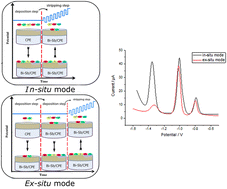A sensor for detecting Zn2+, Cd2+, and Pb2+ ions simultaneously based on the square wave anodic stripping response at a bismuth antimony (Bi–Sb) nanocomposite electrode was developed. The electrode was prepared in situ by electrodepositing bismuth and antimony on the surface of a carbon-paste electrode (CPE) while also reducing the analyte metal ions. The structure and performance of the Bi–Sb/CPE electrode were studied using scanning electron microscopy, X-ray diffraction, electrochemical impedance spectroscopy, and cyclic voltammetry. Operational conditions including the concentration of Sb and Bi, the type of electrolyte, pH, and preconcentration conditions were optimized. The linear ranges were determined to be 5–200 μg L−1 for Zn2+, 1–200 μg L−1 for Cd2+, and 1–150 μg L−1 for Pb2+ with the optimized parameters. The limits of detection were 1.46 μg L−1, 0.27 μg L−1, and 0.29 μg L−1 for Zn2+, Cd2+, and Pb2+, respectively. Furthermore, the Bi–Sb/CPE sensor is capable of selective determination of the target metals in the presence of the common cationic and anionic interfering species (Na+, K+, Ca2+, Mg2+, Fe3+, Mn2+, Co2+, Cl−, SO42− and HCO3−). Finally, the sensor was successfully applied to the simultaneous determination of Zn2+, Cd2+, and Pb2+ in a variety of real-world water samples.

